Yungang Grottoes: Marvellous Example Of Ancient Buddhist Rock-Cut Architecture
A. Sutherland - AncientPages.com - Yungang Grottoes is a stone carving treasure that is renowned all around the world.
Richly decorated grottoes, known as Wuzhoushan Grottoes in ancient times, are located on the southern foot of the Wuzhou Mountains, in the Shi Li River valley, 16 km west of Datong City.
There are 45 main caves, 252 niches (for a statue of Buddha) of different sizes and more than 50,000 stone statues (completed in sixty years) in which the largest one is as high as 17 meters while the small ones are only several centimeters in height.
The site stretches about 1 kilometer from east to west.
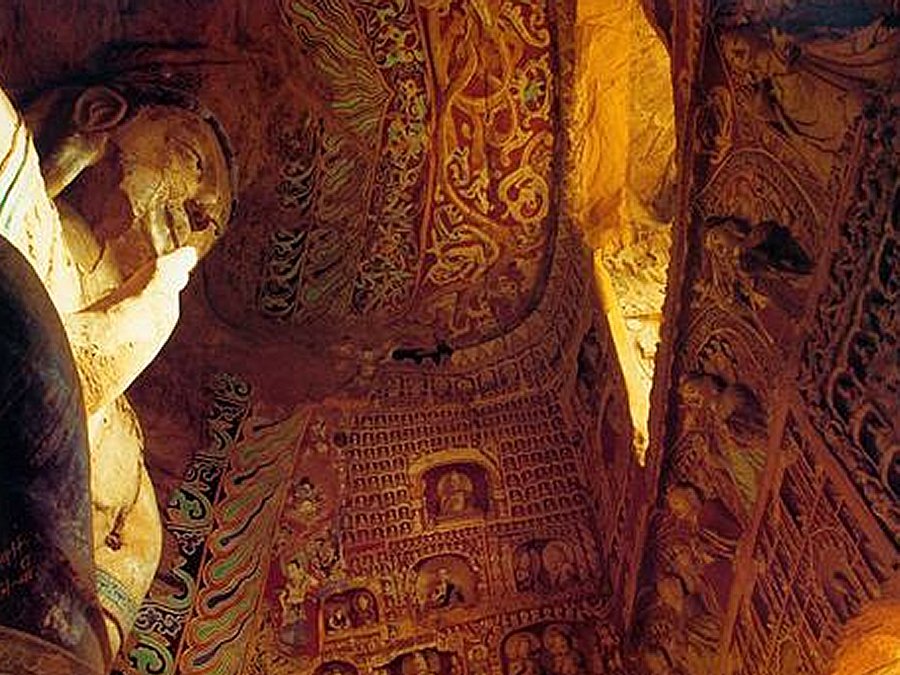
Three main periods can be identified in the construction: the Early Period (460-65), the Middle Period (c . 471-94) and the Late Period (494-525). Apart from the grottoes, the nominated core area includes the remains of a castle, a defence wall, and a beacon tower of the Ming dynasty on the plain above the grottoes. Credits: Cultural China
The ancient Chinese Buddhist temple grottoes that are excellent examples of rock-cut architecture, representing the outstanding Buddhist grotto arts of ancient China in the 5th to 6th century.
Yungang Grottoes were firstly cut in 453A.D. Although the statue making project lasted to 525A.D. most of the stone carvings in the grottoes were completed in 494A.D. Some 40,000 people, including the Buddhists from what is present Sri Lanka, contributed to the huge project.
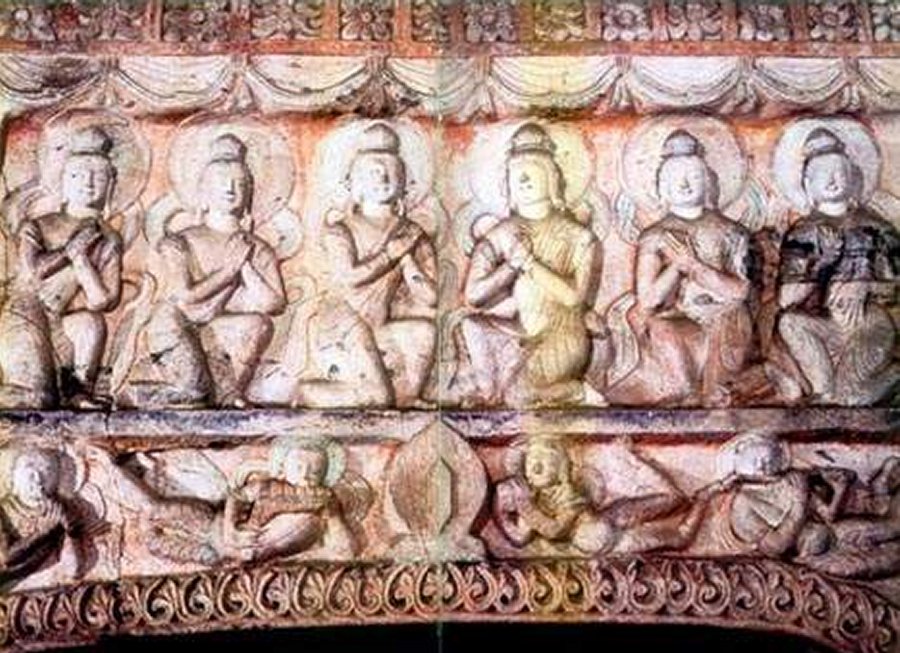
The arrangement and decoration of the grottoes predominantly demonstrates the style of Chinese buildings. In addition, the dance with accompaniment, Baixi (recreational activities of the masses) and acrobatics carvings left in the grottoes all reflect the characters of the ideas of Buddhism in different dynasties and the social life in these times.
According to the time of cutting, these grottoes can be divided into the early, middle and late stages.
The early statues are characterized by vigorous and unsophisticated customs of the Western Region while the grottoes of the middle stage are delicate and luxurious, showing complicated and changing artistic styles.
The move of the Northern Wei capital to Datong in 494 ended the intense period of construction and carving. There was some restoration during the Sui and Tang dynasties, and important repairs were carried out in the 11th and 12th centuries under the Liang Dynasty and later under the Qin.
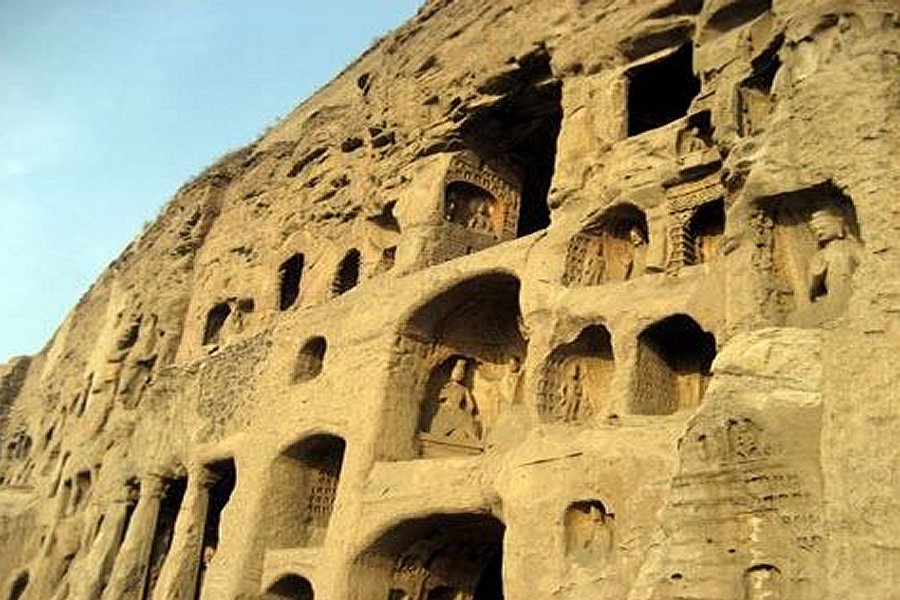
Carved out of a sandstone mountain these caves contain more than 50,000 Buddha sculptures with the oldest and the largest constructed in 460 AD. Credits: Cultural China
These restorations continue today. Much of its history lies shrouded in mystery. The cave sites have only few inscriptions.
The complex consists of large caves, including four groups of twin caves and one group of triple caves with the walls in the east, west and south sides, fully decorated with the statues of Buddha, even the roof is decorated with dancing fairies, centered with a lotus, which are very stately and graceful in appearance.
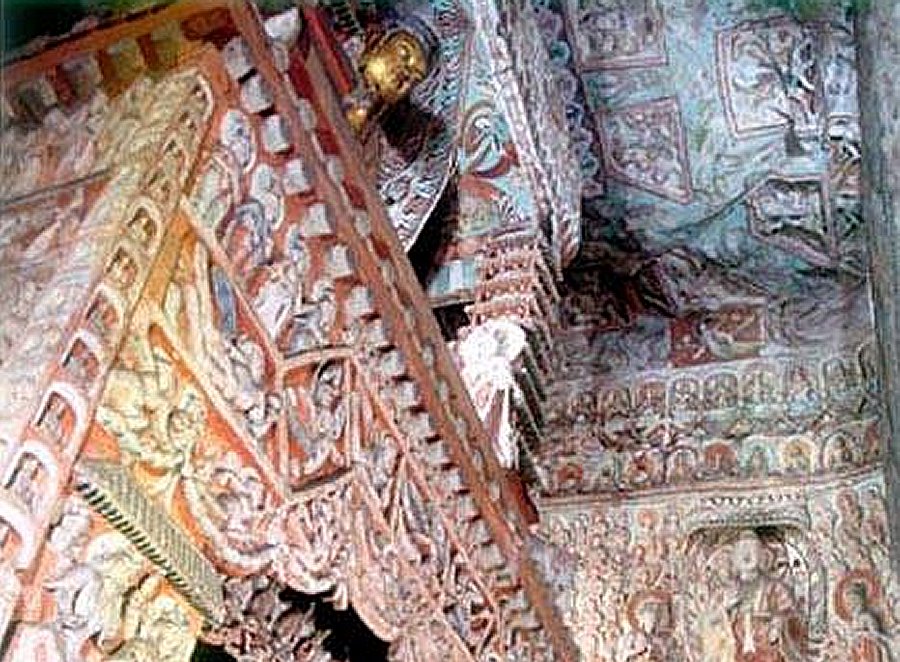
Yungang Grottoes, known as Wuzhoushan Grottoes. In 2001, the Yungang Grottoes were made a UNESCO World Heritage Site. Credits: Cultural China
The Chinese palace building carvings and the Chinese style niche evolved on this foundation were all widely used in the construction of grotto temples in later times.
Although the scale of the grottoes of the late stage was reduced, the proportion of characters was appropriate.
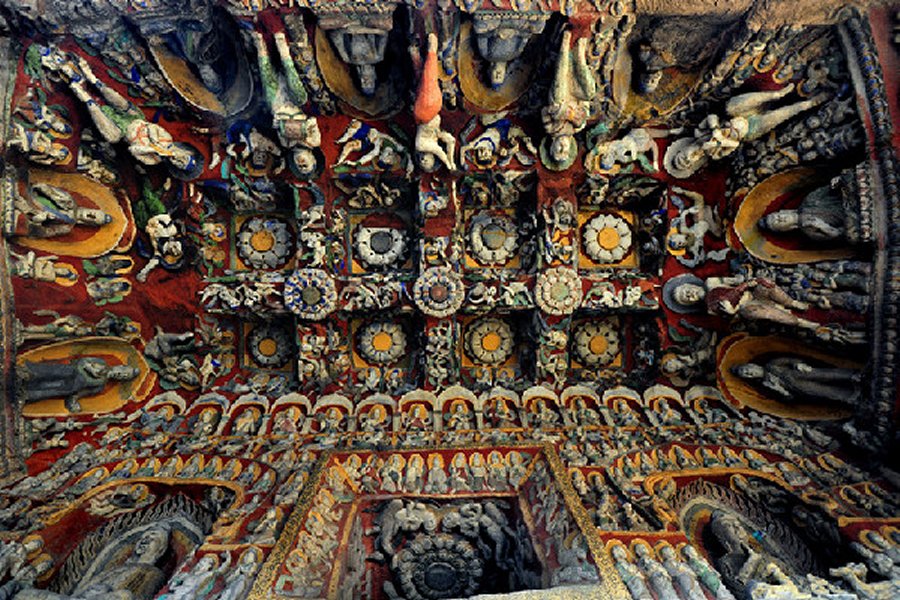
The Yungang Grottoes, in Datong city, Shanxi Province, with their 252 caves and 51,000 statues, represent the outstanding achievement of Buddhist cave art in China in the 5th and 6th centuries.
Credits: China Daily
The arrangement and decoration of the grottoes predominantly demonstrates the style of Chinese buildings.
In addition, the dance with accompaniment, Baixi (recreational activities of the masses) and acrobatics carvings left in the grottoes all reflect the characters of the ideas of Buddhism in different dynasties and the social life in these times.
The whole grotto complex is magnificent with delicate carvings. All the statues are precious and vivid, representing the development of art, architecture, music and religion at that time.
Yungang is a relic of the Northern Wei Dynasty (386-534) of the nomadic Toba people. They recruited 3,000 monks from along the Silk Route to turn Buddhism into their state religion.
In 2001, the Yungang Grottoes were made a UNESCO World Heritage Site.
Copyright © AncientPages.com All rights reserved. This material may not be published, broadcast, rewritten or redistributed in whole or part without the express written permission of AncientPages.com
Expand for references
More From Ancient Pages
-
 3,000-Year-Old Recycling Center In What Is Now Dubai – Discovered
Archaeology | Jan 8, 2020
3,000-Year-Old Recycling Center In What Is Now Dubai – Discovered
Archaeology | Jan 8, 2020 -
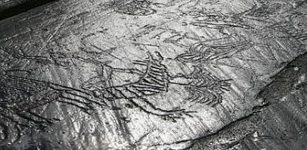 Ausevik Rock Art: Real And Mythical World Of Stone Age People Of Norway
Civilizations | Oct 2, 2018
Ausevik Rock Art: Real And Mythical World Of Stone Age People Of Norway
Civilizations | Oct 2, 2018 -
 Shepherd’s Graffiti Sheds New Light On Acropolis Lost Temple Mystery – New Research
Featured Stories | Jun 17, 2024
Shepherd’s Graffiti Sheds New Light On Acropolis Lost Temple Mystery – New Research
Featured Stories | Jun 17, 2024 -
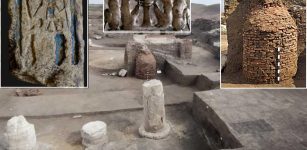 Remains Of Colonnaded Hall Of 26th Dynasty Found At Ancient Buto Temple, Northern Nile Delta
Archaeology | Nov 18, 2022
Remains Of Colonnaded Hall Of 26th Dynasty Found At Ancient Buto Temple, Northern Nile Delta
Archaeology | Nov 18, 2022 -
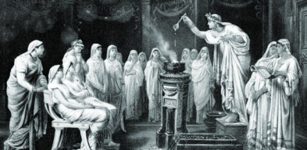 Ancient Romans Loved White Teeth – All Means Were Acceptable To Get Them Even Portuguese Urine
Ancient History Facts | Dec 10, 2017
Ancient Romans Loved White Teeth – All Means Were Acceptable To Get Them Even Portuguese Urine
Ancient History Facts | Dec 10, 2017 -
 On This Day In History: Battle Of Marton, Part Of Viking Invasions Of England Took Place – On Mar 22, 871
News | Mar 22, 2017
On This Day In History: Battle Of Marton, Part Of Viking Invasions Of England Took Place – On Mar 22, 871
News | Mar 22, 2017 -
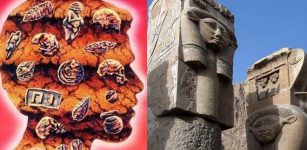 Archaeological Evidence That Has Been Suppressed In The Name Of ‘Scientific Conformity’
Featured Stories | Sep 4, 2014
Archaeological Evidence That Has Been Suppressed In The Name Of ‘Scientific Conformity’
Featured Stories | Sep 4, 2014 -
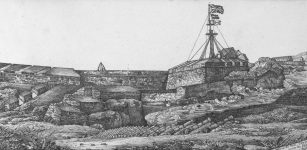 Thousands Of Cannonballs Discovered In Southern India
Archaeology | Dec 23, 2015
Thousands Of Cannonballs Discovered In Southern India
Archaeology | Dec 23, 2015 -
 Incredible 5,000-Year-Old Temple Complex In Orkney Could Re-Write History Of Scotland
Civilizations | Jul 30, 2014
Incredible 5,000-Year-Old Temple Complex In Orkney Could Re-Write History Of Scotland
Civilizations | Jul 30, 2014 -
 Neanderthals’ Lack Of Drawing Ability Could Explain Why Modern Humans Became Smarter
Archaeology | Feb 11, 2018
Neanderthals’ Lack Of Drawing Ability Could Explain Why Modern Humans Became Smarter
Archaeology | Feb 11, 2018 -
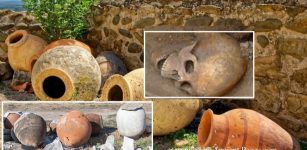 Researchers Develop New Ways Of Visualizing Ancient Small Objects By Combining Technologies
Archaeology | Apr 20, 2022
Researchers Develop New Ways Of Visualizing Ancient Small Objects By Combining Technologies
Archaeology | Apr 20, 2022 -
 Strange Radiation Case – Medical Files Secretly Erased?
Featured Stories | Sep 13, 2019
Strange Radiation Case – Medical Files Secretly Erased?
Featured Stories | Sep 13, 2019 -
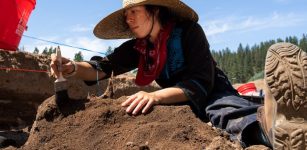 6,000-Year-Old Earth Ovens Discovered In Washington State
Archaeology | Jun 21, 2023
6,000-Year-Old Earth Ovens Discovered In Washington State
Archaeology | Jun 21, 2023 -
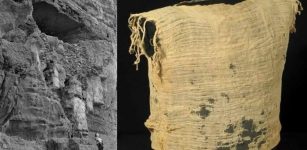 1,900-Year-Old Child’s Nightgown Found In Judean Cave Of Letters
Archaeology | Oct 5, 2023
1,900-Year-Old Child’s Nightgown Found In Judean Cave Of Letters
Archaeology | Oct 5, 2023 -
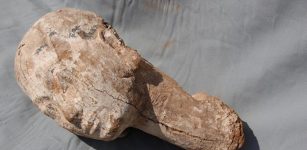 Ancient Wooden Sculpture Of Queen Ankhesenpepi II Discovered At Saqqara, Egypt
Archaeology | Oct 18, 2017
Ancient Wooden Sculpture Of Queen Ankhesenpepi II Discovered At Saqqara, Egypt
Archaeology | Oct 18, 2017 -
 Pax Mongolica: Time Of Peace And Stability That Helped To Spread Technologies And Inventions
Ancient History Facts | Mar 28, 2016
Pax Mongolica: Time Of Peace And Stability That Helped To Spread Technologies And Inventions
Ancient History Facts | Mar 28, 2016 -
 Major Archaeological Discovery Of A 7,000-Year-Old Settlement In Miami – But Its Future Is In Danger
Archaeology | Feb 10, 2023
Major Archaeological Discovery Of A 7,000-Year-Old Settlement In Miami – But Its Future Is In Danger
Archaeology | Feb 10, 2023 -
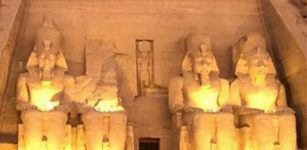 Magnificent Solar Alignment Phenomenon In Abu Simbel – The Sun Illuminates The Face Of Pharaoh Ramses II
Featured Stories | Nov 11, 2020
Magnificent Solar Alignment Phenomenon In Abu Simbel – The Sun Illuminates The Face Of Pharaoh Ramses II
Featured Stories | Nov 11, 2020 -
 On This Day In History: Great Fire Of London Ends – On Sep 5/6, 1666
News | Sep 5, 2016
On This Day In History: Great Fire Of London Ends – On Sep 5/6, 1666
News | Sep 5, 2016 -
 America’s Mysterious Pedro Mountain Mummy And The Hidden Race Of Little People
Featured Stories | Jul 3, 2014
America’s Mysterious Pedro Mountain Mummy And The Hidden Race Of Little People
Featured Stories | Jul 3, 2014
